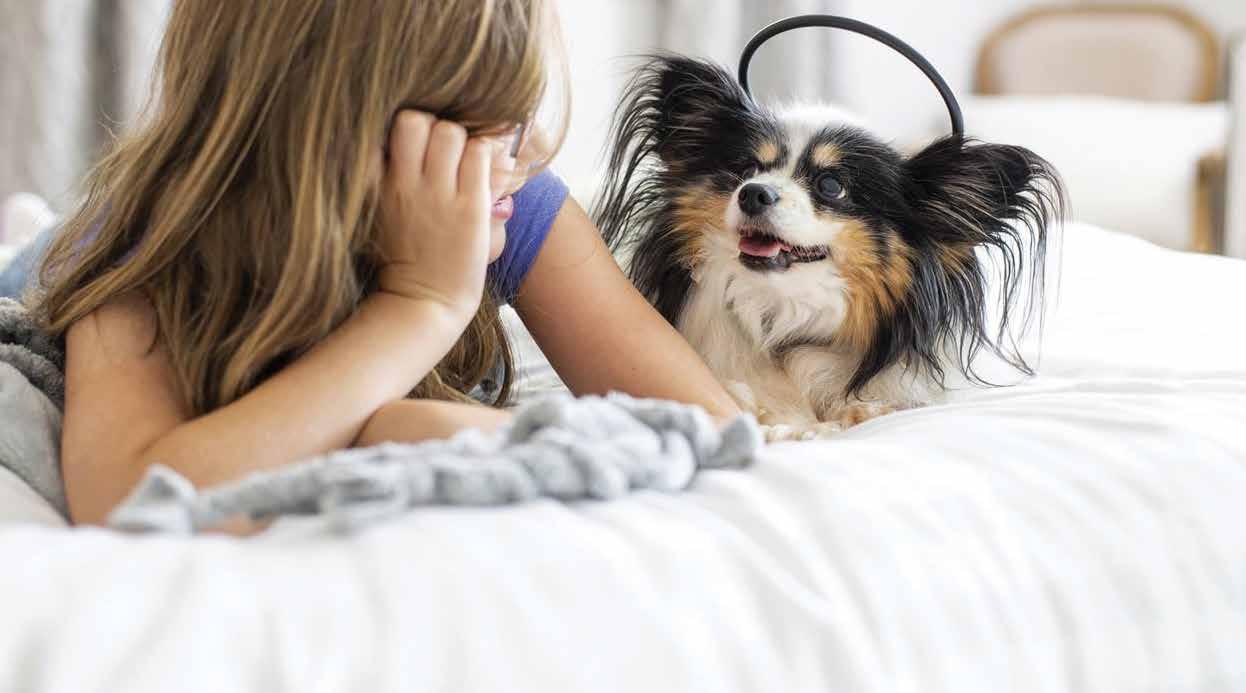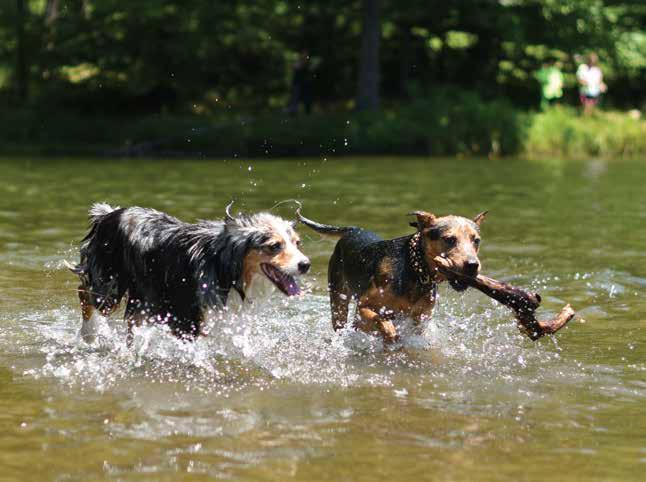
10 minute read
Care Plan for Your Pet
Got a Care Plan in Place for Your Pet in the Event of a Crisis?
HERE'S WHAT YOU CAN DO NOW
to preparing for yourself and the people in your life. In the
event of an emergency, advance preparation for the care of your
pet is vital to your pet's wellness.
COVID-19 hospitalization is just one of the many situations
that could require last-minute care for your pets. But many
other crises could also require arrangements for your pet's care.
Examples include other illnesses requiring hospitalization,
last-minute travel for emergencies or work, homelessness
and eviction, financial hardship, rehab, natural disasters,
deployment, death, and more. Your pet is an important part of
your family. So make sure you have a sufficient plan in place
for your pet before a potential crisis hits.
Who will watch your pet?
In times of crisis, especially community-wide or family
situations that affect other people as well, such as COVID-19,
your first plan may not work out. So have a backup plan, so
you aren't left scrambling. There are many options available
depending on your financial situation, preferences for your pet,
and the length or type of care you may need.
If there's one thing the spread of COVID-19 has taught us, it's to expect and plan for the unexpected. This doesn't just apply
watch your pet. Since you know them, and likely so does your
pet, family and friends may be more likely or able to provide
care in your home or take your pet into their own home. Family
and friends offer pets a familiar face and perhaps even a
familiar place. This can be particularly helpful to ease your pet's
stress. So ask if any friends or family members are willing to
watch or take-in your pet, even if only until suitable options can
be arranged.
• Trusted family or friends are an excellent option, if any can
By: Kimberly Blaker
• Some shelters offer temporary foster placement for a specific amount of time with the intent to reunite pets with their owners.
• Dog and cat boarding kennels, in-home boarding services, and pet hotels are available to host your pets when needed. Be sure to read reviews, tour the facilities, and ask questions in advance to ensure your pet will be well-cared for and according to your preferences.
• There are also pet sitting or walking services depending on the situation and needs of your pet. These are good options for shorter-term situations, and when your pet doesn't need as much care or would just do better at home than in an unfamiliar place.
• Your veterinarian may also be able to offer recommendations since vets often know many of the local services. Veterinarians also know your pet and are more likely to be invested in making sure your pet is taken care of.
• Non-profit organizations like RedRover.org offer resources and ways to help in case of an emergency to make sure pets are cared for.
Whatever options you choose, get to know your emergency caregivers ahead of time, if possible. Also let them get to know your pet and vice versa, and make sure the caregiver understands your pet's needs. In the event of a crisis, you'll feel more at ease knowing your pet is in good hands.
Maintain your pet's health
Emergency preparedness requires maintaining your pet's health. Make sure your pet is up to date on vaccinations and medical check-ups. You should also keep a sufficient supply of any prescriptions, special foods, or other needs on hand to ensure your pet's health in unforeseen circumstances. Also, keep the documentation for proof of shots and spaying or neutering in an accessible place, since these may be required by kennels, shelters, or foster services.
Prepare written instructions for your pet's care
Create instructions for your pet's care and keep both virtual and printed copies. Give one to anyone who may look after your pet. Also, post a copy on your fridge or in a conspicuous place in your home in the event you aren't able to point it out. Every pet is different and keeping the same routine as much as possible will ease your pet's stress during a crisis.
You'll also want caregivers to know about any special needs, such as medications and when your pet needs to see the vet again. The caregiver should be aware of special foods your pet needs or can't have. Your pet's stress level and other avoidable problems can be reduced if the caregiver knows your pet's training commands, personality quirks, behaviors, and things to watch for. The instructions should also include contact numbers for you, your pet's vet, and emergency contact if something should happen. Keep a bag packed for emergencies with the basic needs for your pet like food, toys, and a leash. Also, include a list of frequently used things you don't want to keep packed, but want to make sure your pet has. This might consist of favorite toys or blankets to provide your pet some sense of normalcy and comfort when away from you. Also, include your list of instructions and routines in the bag. Then keep the bag easily accessible and near a crate or whatever you use to safely transport your pet.
Help caregivers ease your pet's stress
During a crisis, pets can experience anxiety or depression, just like people, especially if they're separated from their family and don't follow their regular routines. So make sure your pet will be in a safe, comfortable environment with people you trust. Hopefully, the caregiver has interacted with your pet in the past, so they are familiar with each other.
Other things caregivers can do to relieve some of your pet's stress include:
• giving gentle physical affection at your pet's comfort level •sticking to routines as much as possible • providing your pet the opportunity for regular exercise • sticking to your pet's usual diet • having a designated quiet space with comfort items from home • playing classical music or turning on TV shows explicitly designed for animals
Although you may not be able to predict when a crisis might turn your life upside down, one thing is within your control. You can have a plan in place for emergencies that ensures your pet will be adequately taken care of, leaving you one less thing to worry about.
About the writer
Kimberly Blaker is a parenting and lifestyle freelance writer. She also writes a blog, The Young Gma's Guide to Parenting at www.theyounggma.com
Pocono Living Magazine 2020 PHOTO CONTEST ENTER YOUR BEST SHOTS
Your photos could be seen by more than 26,000 readers when you enter them in Pocono Living Magazine’s Annual Photo Contest. The contest is open to amateur photographers only. (Those who do not earn a majority, over half, of their income as photographers). You may enter no more than 15 images, so choose your best shots. Categories are “Scenics”, “Wildlife”, “Florals”, and “Historical Structures”. Only photographs that are representative of the Pocono Mountains should be submitted. Individual photos should be attached to an email message and sent to: pmags@ptd.net. Photos submitted must be high resolution, (300 dpi), jpg or tiff files or they cannot be used. You must include your full name in the title with each photo submitted as you would like it to appear in the magazines. We will contact you for your mailing address to receive your prize if your photo is chosen as a winner in the contest. Winning photos, along with the names, and hometowns if available, of each winner will appear in the October/November 2020 issue of Pocono Living Magazine and the Pocono Magazines.com website. Some lucky participants may have their photo featured as a cover on Pocono Living Magazine!
PRIZES AWARDED:
1st Place: $100.00 in Gift Certificates to Local Restaurants & Shoppes 2nd Place: $75.00 in Gift Certificates to Local Restaurants & Shoppes 3rd Place: $50.00 in Gift Certificates to Local Restaurants & Shoppes Honorable Mentions: One year subscription to Pocono Living & Pocono Family Magazines. In the event of a tie, prize money will be split among the winners.
RULES OF THE CONTEST:
1. Contest open to amateur photographers only. 2. Contest opens April 1, 2020 and closes August 1, 2020. 3. Enter electronic files by email to: pmags@ptd.net. One photo at a time. 4. Submitted photos must be as an attachment to an email message, (not within the body of the email), and be high resolution (300 dpi), jpeg or tiff files. 5. Please include your contact information (phone number, mailing address & email address) with the submission. 6. Each contestant may submit no more than 15 photographs. Choose any combination of categories. 7. Photos submitted may be judged for inclusion in this year’s contest, and in all future year’s contests, so you have several chances to be a winner. 8. Entered photos must have been taken recently, from January 2012 to present and be of a scene or subject found in the Pocono Mountains only. 9. Categories are: Scenics (landscapes, rivers, lakes, waterfalls, etc.), Wildlife, Florals, and Historical Structures. 10. Judging will take place in August and September 2020 and winners will appear in the October/November issue of Pocono Living Magazine. 11. Winners will receive gift certificates within 90 days after being published. 12. Contestants will retain all rights to their photography, but agree that Pocono Magazines, LLC and Pocono Mts. Publications, LLC may use their photos from time to time in the magazines that they publish and on the Pocono Magazines.com website provided proper credit is given to each photographer.

For almost all of us, we have been on "sit and stay" for over two months. The only person happy about this is the dog. The question is, when we return to some normalcy, and head back to work, or to re-start life, what will be the effect on our canines? Some dogs are at higher risk for anxiety when we return to our new normal.
Dogs previously diagnosed with Canine Separation Anxiety should return to preventative measures before the owner returns to work. For dogs adopted during the "stay at home" regulations, their new owners should start leaving the dog alone for short periods of time, testing reactions. For the dog never exhibiting any tendency toward anxiety, owners should be vigilant; the events of the past two months were anxiety-producing for all of us, and that includes the canines. Fortunately, new drug-free solutions are now available to help our canine companions feel calmer.
"Research shows that more than one in seven dogs (13 million) in the U.S. suffer from separation anxiety. We expect this figure to dramatically increase once stay at home restrictions are lifted," said Dr. Judy Korman, veterinarian at Assisi Animal Health. "What might be initially viewed as bad behavior is actually a cry for help."
When Jen Berger first got her bulldog Eggnog, she was a joy until Jen had to leave the house. Eggnog paced constantly until she returned. Jen thought this was simply due to Eggnog's young age, but instead of the problem improving as she grew, it
actually got worse.
SYMPTOMS OF CANINE SEPARATION ANXIETY Dogs with separation anxiety panic and exhibit behavior problems when they can't be with their owners. Below, Dr. Korman shares the most common symptoms of separation
anxiety:
Vocalizing: Barks, howls or whines when you leave or while
you're gone.
Escaping: Chews or scratches at doors or windows in an attempt
to escape the home, a crate or exercise pen.
Destructiveness: Chews or scratches on household items when
you're gone.
Pacing: Constant walking in a circle or back and forth as you're
leaving or when you're gone.
Panting: Heavy breathing as you're leaving or after you're gone.










